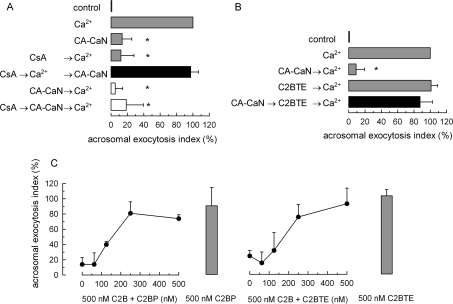FIGURE 7.
Phosphorylated synaptotagmin has an active role at early stages of the secretory process. A, permeabilized spermatozoa were treated with 2 μm CsA and then stimulated with 10 μm free Ca2+ for 15 min at 37 °C to allow exocytosis to proceed to the calcineurin-dependent step, and finally the inhibition of CsA was relieved by adding 50 nm CA-CaN (black bar). Control experimental conditions (gray bars) include background AE in the absence of any stimulation (control), AE stimulated by 10 μm free Ca2+, and the inhibitory effect of CsA. Two conditions, initially thought as controls, gave unexpected results. When sperm were treated with CA-CaN before activating with calcium (irrespective of the presence of CsA), exocytosis was inhibited (white bars). B, permeabilized spermatozoa were treated with 50 nm CA-CaN for 15 min at 37 °C, then 500 nm C2BTE were added, and finally AE was stimulated with 10 μm free Ca2+ for 15 min at 37 °C (black bar). Control experimental conditions (gray bars) include background AE in the absence of any stimulation (control), AE stimulated by 10 μm free Ca2+, the inhibitory effect of CA-CaN when added before stimulation, and the lack of effect of C2BTE in calcium-triggered exocytosis. C, permeabilized spermatozoa were treated with 500 nm wild type C2B domain in the presence of increasing concentrations of phosphorylated C2B domain (C2BP, left panel) or the phosphomimetic C2B domain (C2BTE, right panel) and stimulated with 10 μm free Ca2+ for 15 min at 37 °C. AE in the presence of 500 nm C2BP or C2BTE is shown as gray bars. The sperm were fixed, and AE was measured. The percentage of reacted sperm was normalized as described under “Experimental Procedures.” The data represent the means ± S.E. of at least three independent experiments. The asterisks indicate significant differences from 100 (one-way ANOVA and 95% confidence interval for each condition).

